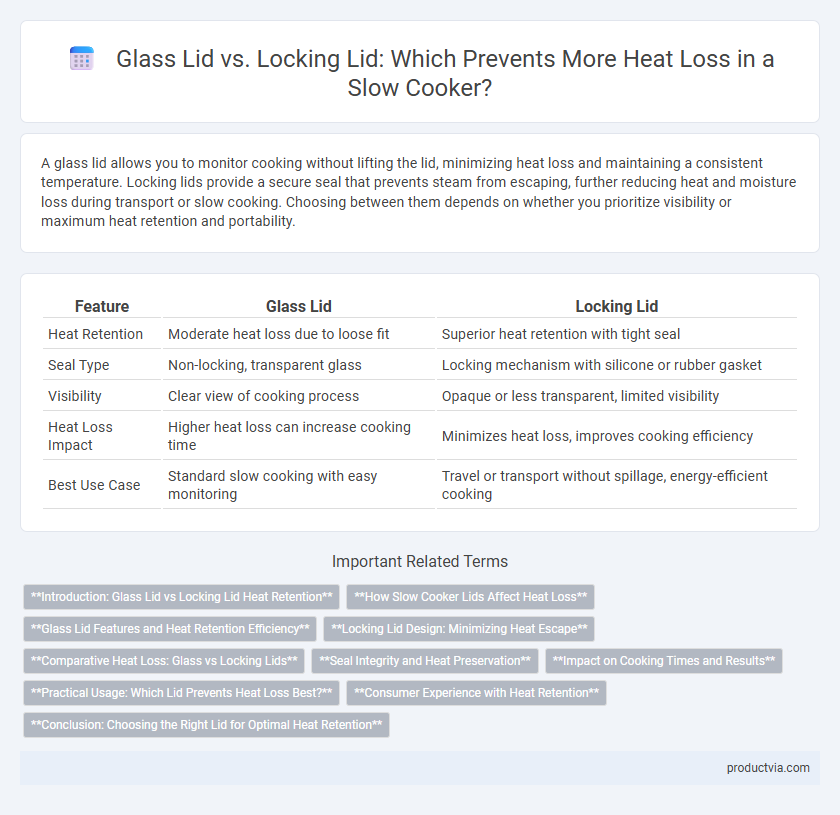A glass lid allows you to monitor cooking without lifting the lid, minimizing heat loss and maintaining a consistent temperature. Locking lids provide a secure seal that prevents steam from escaping, further reducing heat and moisture loss during transport or slow cooking. Choosing between them depends on whether you prioritize visibility or maximum heat retention and portability.
Table of Comparison
| Feature | Glass Lid | Locking Lid |
|---|---|---|
| Heat Retention | Moderate heat loss due to loose fit | Superior heat retention with tight seal |
| Seal Type | Non-locking, transparent glass | Locking mechanism with silicone or rubber gasket |
| Visibility | Clear view of cooking process | Opaque or less transparent, limited visibility |
| Heat Loss Impact | Higher heat loss can increase cooking time | Minimizes heat loss, improves cooking efficiency |
| Best Use Case | Standard slow cooking with easy monitoring | Travel or transport without spillage, energy-efficient cooking |
Introduction: Glass Lid vs Locking Lid Heat Retention
Glass lids provide clear visibility and moderate heat retention in slow cookers, allowing steam to escape and preventing pressure buildup. Locking lids create a tighter seal that minimizes heat and moisture loss, enhancing cooking efficiency and preserving flavors. Choosing between them depends on the need for portability versus optimal heat retention during slow cooking.
How Slow Cooker Lids Affect Heat Loss
Glass lids allow visible monitoring of cooking progress without lifting the lid, but they can cause more heat loss due to the lack of a secure seal. Locking lids create a tighter seal that minimizes steam escape and heat loss, promoting more efficient and consistent cooking temperatures. Choosing a locking lid enhances heat retention, reducing cooking time and energy consumption in slow cookers.
Glass Lid Features and Heat Retention Efficiency
A glass lid on a slow cooker offers clear visibility, allowing users to monitor cooking progress without lifting the lid and releasing heat. This transparency helps maintain steady internal temperatures, improving heat retention efficiency. However, glass lids typically lack sealing mechanisms found in locking lids, which can lead to slightly greater heat loss during cooking.
Locking Lid Design: Minimizing Heat Escape
Locking lid designs in slow cookers create a secure seal that significantly reduces heat escape, ensuring consistent cooking temperatures and efficient energy usage. Unlike glass lids, which can allow heat to dissipate around the edges, locking lids maintain pressure and moisture inside the pot, enhancing flavor and tenderness. This design is especially beneficial for slow cookers used during travel or transportation, preventing spills and heat loss simultaneously.
Comparative Heat Loss: Glass vs Locking Lids
Glass lids typically allow more heat loss compared to locking lids due to their loose fit and lack of airtight seal, which causes steam to escape during cooking. Locking lids create a tight seal that minimizes heat and moisture loss, enhancing heat retention and ensuring more consistent cooking temperatures. Studies show locking lids can reduce heat loss by up to 30%, improving slow cooker efficiency and energy use.
Seal Integrity and Heat Preservation
Glass lids offer moderate seal integrity with a loose fit that can lead to significant heat loss during cooking, reducing slow cooker efficiency. Locking lids provide superior seal integrity by securely clamping down, minimizing heat and moisture escape, which preserves internal temperature and enhances cooking consistency. Effective heat preservation with locking lids ensures energy efficiency and better retention of flavors and nutrients in slow-cooked meals.
Impact on Cooking Times and Results
Glass lids allow easy monitoring of the cooking process without releasing heat, minimizing heat loss and maintaining consistent cooking temperatures for even, predictable results. Locking lids create a tighter seal, preventing steam escape and reducing heat loss further, which can accelerate cooking times and enhance moisture retention in dishes. Choosing between glass and locking lids affects heat retention, which directly influences cooking duration and the texture of slow-cooked meals.
Practical Usage: Which Lid Prevents Heat Loss Best?
A locking lid prevents heat loss better than a glass lid by creating a tighter seal that minimizes steam escape during cooking. Glass lids, while convenient for monitoring food, often allow more heat and moisture to escape, resulting in longer cooking times and less efficient heat retention. For practical slow cooker use, locking lids enhance energy efficiency and maintain consistent cooking temperatures.
Consumer Experience with Heat Retention
Glass lids on slow cookers allow consumers to monitor cooking progress without lifting the lid, reducing heat loss and maintaining consistent temperatures for optimal results. Locking lids provide a secure seal that minimizes heat and moisture escape during transport, enhancing heat retention and ensuring evenly cooked meals. Users often prefer locking lids for portability and glass lids for ease of monitoring, balancing heat retention with convenience.
Conclusion: Choosing the Right Lid for Optimal Heat Retention
Glass lids provide excellent heat retention by creating a tight seal that traps steam and moisture, enhancing cooking efficiency in slow cookers. Locking lids are designed primarily for secure transport and may allow slight heat loss due to their sealing mechanism, making them less ideal for maintaining consistent cooking temperatures. For optimal heat retention, a glass lid is the preferred choice when the primary goal is steady, efficient slow cooking performance.
Glass lid vs Locking lid for heat loss Infographic

 productvia.com
productvia.com